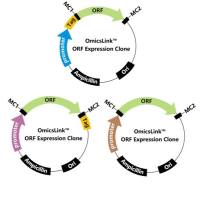Pathway‐Based Analysis of Microarray and RNAseq Data Using Pathway Processor 2.0
互联网
- Abstract
- Table of Contents
- Figures
- Literature Cited
Abstract
The constant improvement of high?throughput technologies has led to a great increase in generated data per single experiment. Pathway analysis is a widespread method to understand experimental results at the system level. Pathway Processor 2.0 is an upgrade over the original Pathway Processor program developed in 2002, extended to support more species, analysis methods, and RNAseq data in addition to microarrays through a simple Web?based interface. The tool can perform two different types of analysis: the first covers the traditional Fisher's Test used by Pathway Processor and topology?aware analyses, which take into account the propagation of changes over the whole structure of a pathway, and the second is a new pathway?based method to investigate differences between phenotypes of interest. Common problems and troubleshooting are also discussed. Curr. Protoc. Bioinform. 41:7.6.1?7.6.12. © 2013 by John Wiley & Sons, Inc.
Keywords: biological pathways; gene expression analysis; Web tool
Table of Contents
- Introduction
- Basic Protocol 1: Functional Analysis of Differentially Expressed Genes
- Basic Protocol 2: Gene Set Variation Analysis of Microarray or RNAseq Data
- Commentary
- Literature Cited
- Figures
Materials
Figures
-
Figure 7.6.1 Example of a properly formatted DEG file. View Image -
Figure 7.6.2 Example of a properly formatted platform file. View Image -
Figure 7.6.3 Example showing the structure of a PWF format file. View Image -
Figure 7.6.4 The Pathway Processor 2.0 main page. View Image -
Figure 7.6.5 The Pathway Processor 2.0 interface for the Fisher's Exact Test and impact analysis. View Image -
Figure 7.6.6 Example results from a Fisher's Test analysis run. View Image -
Figure 7.6.7 Example results from an impact analysis run. View Image -
Figure 7.6.8 Overlay of DEGs over a significant pathway. View Image -
Figure 7.6.9 The Pathway Processor 2.0 interface for GSVA. View Image -
Figure 7.6.10 The interface for selecting cases and controls during GSVA. View Image -
Figure 7.6.11 Example results from a GSVA run. View Image
Videos
Literature Cited
| Literature Cited | |
| Beltrame, L., Rizzetto, L., Paola, R., Rocca‐Serra, P., Gambineri, L., Battaglia, C., and Cavalieri, D. 2009. Using pathway signatures as means of identifying similarities among microarray experiments. PLoS One 4:e4128. | |
| Cavalieri, D. and De Filippo, C. 2005. Bioinformatic methods for integrating whole‐genome expression results into cellular networks. Drug Discov. Today 10:727‐734. | |
| Draghici, S., Khatri, P., Martins, R.P., Ostermeier, G.C., and Krawetz, S.A. 2003. Global functional profiling of gene expression. Genomics 81:98‐104. | |
| Draghici, S., Khatri, P., Tarca, A. L., Amin, K., Done, A., Voichita, C., Georgescu, C., and Romero, R. 2007. A systems biology approach for pathway level analysis. Genome Res. 17:1537‐1545. | |
| Grosu, P., Townsend, J.P., Hartl, D.L., and Cavalieri, D. 2002. Pathway Processor: A tool for integrating whole‐genome expression results into metabolic networks. Genome Res. 12:1121‐1126. | |
| Joshi‐Tope, G., Gillespie, M., Vastrik, I., D'Eustachio, P., Schmidt, E., de Bono, B., Jassal, B., Gopinath, G.R., Wu, G.R., Matthews, L., Wu, G., Birney, E., and Stein, L. 2005. Reactome: A knowledgebase of biological pathways. Nucleic Acids Res. 33:D428‐D432. | |
| Kanehisa, M., Goto, S., Kawashima, S., and Nakaya, A. 2002. The KEGG databases at GenomeNet. Nucleic Acids Res. 30:42‐46. | |
| Khatri, P., Sirota, M., and Butte, A.J. 2012. Ten years of pathway analysis: Current approaches and outstanding challenges. PLoS Comput. Biol. 8:e1002375. | |
| Manoli, T., Gretz, N., Gröne, H.‐J., Kenzelmann, M., Eils, R., and Brors, B. 2006. Group testing for pathway analysis improves comparability of different microarray datasets. Bioinformatics 22:2500‐2506. | |
| Sales, G., Calura, E., Cavalieri, D., and Romualdi, C. 2012. Graphite—a bioconductor package to convert pathway topology to gene network. BMC Bioinformatics 13:20. | |
| Schaefer, C.F., Anthony, K., Krupa, S., Buchoff, J., Day, M., Hannay, T., and Buetow, K.H. 2009. PID: The Pathway Interaction Database. Nucleic Acids Res. 37:D674‐D679. | |
| Smoot, M.E., Ono, K., Ruscheinski, J., Wang, P.‐L., and Ideker, T. 2011. Cytoscape 2.8: New features for data integration and network visualization. Bioinformatics 27:431‐432. | |
| Smyth, G.K. 2005. Limma: Linear models for microarray data. In Bioinformatics and Computational Biology Solutions using R and Bioconductor (R. Gentleman, V. Carey, S. Dudoit, R. Irizarry, and W. Huber, eds.) pp. 397‐420. Springer, New York. | |
| Subramanian, A., Tamayo, P., Mootha, V.K., Mukherjee, S., Ebert, B.L., Gillette, M.A., Paulovich, A., Pomeroy, S.L., Golub, T.R., Lander, E.S., and Mesirov, J.P. 2005. Gene set enrichment analysis: A knowledge‐based approach for interpreting genome‐wide expression profiles. Proc. Natl. Acad. Sci. U.S.A. 102:15545‐15550. | |
| Tarca, A.L., Draghici, S., Khatri, P., Hassan, S.S., Mittal, P., Kim, J.‐S., Kim, C.J., Kusanovic, J.P., and Romero, R. 2009. A novel signaling pathway impact analysis. Bioinformatics 25:75‐82. |









